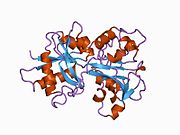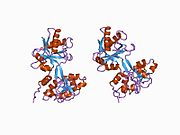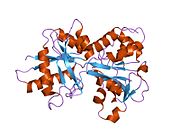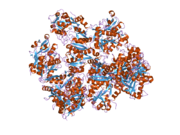Transferrin
Ensembl | |||||||||
|---|---|---|---|---|---|---|---|---|---|
| UniProt | |||||||||
| RefSeq (mRNA) | |||||||||
| RefSeq (protein) | |||||||||
| Location (UCSC) | Chr 3: 133.75 – 133.8 Mb | Chr 9: 103.08 – 103.11 Mb | |||||||
| PubMed search | [3] | [4] | |||||||
| View/Edit Human | View/Edit Mouse |
| Transferrin | |||||||||
|---|---|---|---|---|---|---|---|---|---|
| Identifiers | |||||||||
| Symbol | Transferrin | ||||||||
SCOP2 | 1lcf / SCOPe / SUPFAM | ||||||||
| |||||||||
Transferrins are
Transferrin
When not bound to iron, transferrin is known as "apotransferrin" (see also
Occurrence and function
Transferrins are glycoproteins that are often found in biological fluids of vertebrates. When a transferrin protein loaded with iron encounters a
).[13]
Humans and other mammals
The
The gene coding for transferrin in humans is located in chromosome band 3q21.[7]
Medical professionals may check serum transferrin level in
Other species
Structure
In humans, transferrin consists of a polypeptide chain containing 679
The
Transferrin also has a transferrin iron-bound
Immune system
Transferrin is also associated with the
Role in disease
An increased plasma transferrin level is often seen in patients with iron deficiency anemia, during pregnancy, and with the use of oral contraceptives, reflecting an increase in transferrin protein expression. When plasma transferrin levels rise, there is a reciprocal decrease in percent transferrin iron saturation, and a corresponding increase in total iron binding capacity in iron deficient states[22]
A decreased plasma transferrin level can occur in iron overload diseases and protein malnutrition. An absence of transferrin results from a rare genetic disorder known as atransferrinemia, a condition characterized by anemia and hemosiderosis in the heart and liver that leads to heart failure and many other complications as well as to H63D syndrome.
Studies reveal that a transferrin saturation (serum iron concentration ÷ total iron binding capacity) over 60 percent in men and over 50 percent in women identified the presence of an abnormality in iron metabolism (Hereditary hemochromatosis, heterozygotes and homozygotes) with approximately 95 percent accuracy. This finding helps in the early diagnosis of Hereditary hemochromatosis, especially while serum ferritin still remains low. The retained iron in Hereditary hemochromatosis is primarily deposited in parenchymal cells, with reticuloendothelial cell accumulation occurring very late in the disease. This is in contrast to transfusional iron overload in which iron deposition occurs first in the reticuloendothelial cells and then in parenchymal cells. This explains why ferritin levels remain relative low in Hereditary hemochromatosis, while transferrin saturation is high.[23][24]
Transferrin and its receptor have been shown to diminish
Transferrin and nanomedicine
Many drugs are hindered when providing treatment when crossing the blood-brain barrier yielding poor uptake into areas of the brain. Transferrin glycoproteins are able to bypass the blood-brain barrier via receptor-mediated transport for specific transferrin receptors found in the brain capillary endothelial cells.[25] Due to this functionality, it is theorized that nanoparticles acting as drug carriers bound to transferrin glycoproteins can penetrate the blood-brain barrier allowing these substances to reach the diseased cells in the brain.[26] Advances with transferrin conjugated nanoparticles can lead to non-invasive drug distribution in the brain with potential therapeutic consequences of central nervous system (CNS) targeted diseases (e.g. Alzheimer's or Parkinson's disease).[27]
Other effects
Carbohydrate deficient transferrin increases in the blood with heavy ethanol consumption and can be monitored through laboratory testing.[28]
Transferrin is an acute phase protein and is seen to decrease in inflammation, cancers, and certain diseases (in contrast to other acute phase proteins, e.g., C-reactive protein, which increase in case of acute inflammation).[29]
Pathology
Atransferrinemia is associated with a deficiency in transferrin.
In nephrotic syndrome, urinary loss of transferrin, along with other serum proteins such as thyroxine-binding globulin, gammaglobulin, and anti-thrombin III, can manifest as iron-resistant microcytic anemia.
Reference ranges
An example reference range for transferrin is 204–360 mg/dL.[30] Laboratory test results should always be interpreted using the reference range provided by the laboratory that performed the test[citation needed].

A high transferrin level may indicate an
Interactions
Transferrin has been shown to
Related proteins
Members of the family include blood serotransferrin (or siderophilin, usually simply called transferrin);
See also
- Beta-2 transferrin
- Transferrin receptor
- Total iron-binding capacity
- Transferrin saturation
- Ferritin
- Optiferrin recombinant human transferrin
- Atransferrinemia
- Hypotransferrinemia
- HFE H63D gene mutation
References
- ^ a b c GRCh38: Ensembl release 89: ENSG00000091513 – Ensembl, May 2017
- ^ a b c GRCm38: Ensembl release 89: ENSMUSG00000032554 – Ensembl, May 2017
- ^ "Human PubMed Reference:". National Center for Biotechnology Information, U.S. National Library of Medicine.
- ^ "Mouse PubMed Reference:". National Center for Biotechnology Information, U.S. National Library of Medicine.
- PMID 3032619.
- PMID 11752780.
- ^ PMID 6585826.
- ^ S2CID 49674402.
- PMID 204636.
- S2CID 13929228.
- ^ PMID 9609685.
- ^ PMID 8218271.
- ^ PMID 1431877.
- ^ PMID 12667060.
- PMID 12553165.
- ^ PMID 18473900.
- PMID 23552219.
- ^ a b c "Transferrin Structure". St. Edward's University. 2005-07-18. Archived from the original on 2012-12-11. Retrieved 2009-04-24.
- S2CID 2981917.
- PMID 17420467.
- PMID 10633294.
- PMID 23613366.
- PMID 21452290.
- ^ "Hemochromatosis". guidelinecentral.com.
- PMID 28639394.
- PMID 23380930.
- PMID 27187189.
- S2CID 12203099.
- PMID 21430962.
- ISBN 0-7216-8462-9.
- S2CID 22895295.
- PMID 11297622.
- PMID 1315521.
- .
Further reading
- Hershberger CL, Larson JL, Arnold B, Rosteck PR, Williams P, DeHoff B, et al. (December 1991). "A cloned gene for human transferrin". Annals of the New York Academy of Sciences. 646 (1): 140–54. S2CID 19519911.
- Bowman BH, Yang FM, Adrian GS (1989). Transferrin: evolution and genetic regulation of expression. Advances in Genetics. Vol. 25. pp. 1–38. PMID 3057819.
- Parkkinen J, von Bonsdorff L, Ebeling F, Sahlstedt L (August 2002). "Function and therapeutic development of apotransferrin". Vox Sanguinis. 83 (Suppl 1): 321–6. S2CID 5876134.
External links
- Transferrin at the U.S. National Library of Medicine Medical Subject Headings (MeSH)
- Overview of all the structural information available in the PDB for UniProt: P02787 (Serotransferrin) at the PDBe-KB.

![Transferrin bound to its receptor.[19]](http://upload.wikimedia.org/wikipedia/commons/thumb/b/b2/PDB_1suv_EBI.jpg/120px-PDB_1suv_EBI.jpg)
![Transferrin receptor complex.[20]](http://upload.wikimedia.org/wikipedia/commons/thumb/b/b1/PDB_2nsu_EBI.jpg/120px-PDB_2nsu_EBI.jpg)





















